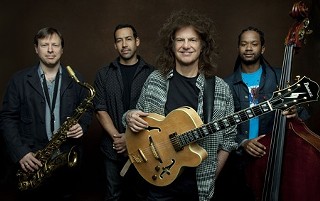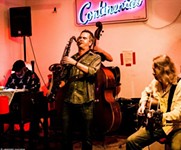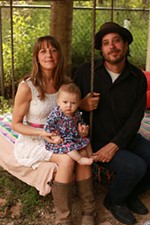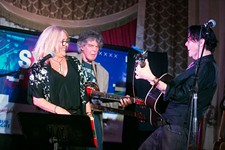15 Minutes with Pat Metheny
Guitar radical still finds the good notes
By Jim Caligiuri, 2:19PM, Wed. Oct. 3, 2012
Pat Metheny brings his Unity Band to the Moody Theater tomorrow, Thursday. It’s the first time in 30 years the renowned jazz guitarist is touring with a saxophonist, this time Chris Potter. Metheny's notorious for never standing still and his most recent past is as radical as he’s ever been.
2010 found him working with the Orchestrion, a Rube Goldberg-type contraption that allowed him to be the world’s biggest and most adventurous one-man band. 2011 was a foray into interpreting songs from the Beatles, Paul Simon, and Burt Bacharach solo on guitar.
Now, he’s working with a fusion band that’s fresh and, as always with Metheny, unpredictable.
Geezerville: You’ve been doing some different things the past few years, moving from project to project. Has that been planned? How do you choose what you’re going to do next?
Pat Metheny: It’s true. In the course of four years now, I’ve done a lot of different kinds of things. Yet at the same time there’s a consistent thread running through the whole thing that connects it for me. It’s my general interest in music and what I’m hoping to express.
I think a lot of people talk about the differences between things. From my stand point, a different way to think about it is the thing that connects everything. To me there’s a logical way that I’m getting from one thing to the next. It’s defined by what’s going on in the touring thing at that moment.
For example, there were these two very different solo records that I did back to back. The Orchestrion thing settled once and for all just exactly how out there I truly am in my interests [laughs]. People would always ask me to do solo concerts. I thought that if I’m going to do solo concerts, I’m going to do something different. So with the Orchestrion thing, we can say ‘mission accomplished.’
I played a lot of solo guitar for that year and that led to the next record, a solo guitar record playing other people’s music, which was something I hadn’t done. That seemed like something worth filling in and led to this record. The next logical thing would be the group, the thing I’ve had going for a really long time. It seemed like after the acoustic record, it would be time to fill in this huge blank I’ve missed. It’s a mystery to me how I’ve gone 40-plus records and made only one conventional horn-plus-rhythm-section kind of record.
There’s some kind of sequence. If I go backward in time, they all seem to flow. Maybe it's all very personal to me, but it usually has to do with what’s going on with the touring thing. Touring has always been the main thing and the records were secondary. Especially how the music business set is set up now.
G: It’s interesting that you’ve been able to combine your interests in technology and music over the years. I find it fascinating that you’ve been able to broaden the way people view the guitar.
PM: One of the things about the guitar is that you say that word and you’re not going to get two people who have the same image in their mind. Someone will think of Segovia being played unamplified and the next guy could think of the guitar player in Megadeth with a stack of 16 Marshalls in a coliseum. It’s an instrument that has this unbelievable variety of meanings.
In my zone of music it was an instrument that was somewhat sonically limited in jazz. In the beginning, the guitar in a band would be playing one sound and that was that. It was about the notes. Let’s say 70 percent of me is that. That’s the core of me, a deep connection to that tradition.
However, around the time that I came along, I asked, ‘Why does it have to be just that? Why can’t it be all these other things to?’ Like textures and a context for improvising that could be more than just that.
G: It’s surprising that you were able to accomplish that and retain an audience. That was a radical idea at the time you were beginning your career.
PM: I’ve always felt big notes have a kind of universal appeal. When I hear someone playing something that adds up to more than what it is, that’s the jazz way of looking at it. There’s endless potential for connecting with people. I’ve always put my faith in that and just played good notes. All the other stuff in the culture is changing, but good notes are good notes. I don’t worry too much about which guitar it is or finding the audience. Those are all incidental to finding good notes. That’s always served me well.
G: There’s one song on the new album, “Signals (Orchestion Sketch),” on which you use the Orchestrion. How did the other players feel about working with it?
PM: I think that for musicians like the guys I’m with now, when they're presented with something they’re not sure about, it’s exciting and challenging. They all more than rose to the occasion. Particularly given the idea that I had. It’s entirely improvised. There’s nothing preset other than there being a sketch that I refer to in the title. It was very limited.
Many people were confused by the Orchestrion and exactly what I was doing. I understand that because even if I took an hour to explain what I was doing to someone who knows what it should be, they were confused. Including my current band [laughs]. It’s convoluted, the way it works. But now they’re experts because we’ve used it at many gigs. I look at it as some raw material that hasn’t been used that much and I think they respond to it that way too.
G: You’re bringing it on the road with you? I envisioned it as a room-filling thing.
PM: It is a room-filling thing! But I’ve developed what we’re calling the Chamber Orchestrion. It’s a much smaller version with very limited stuff. In the context of this, it’s enough stuff that I can get to something.
A note to readers: Bold and uncensored, The Austin Chronicle has been Austin’s independent news source for over 40 years, expressing the community’s political and environmental concerns and supporting its active cultural scene. Now more than ever, we need your support to continue supplying Austin with independent, free press. If real news is important to you, please consider making a donation of $5, $10 or whatever you can afford, to help keep our journalism on stands.
Jim Caligiuri, Sept. 18, 2013
April 14, 2017
March 18, 2017
Pat Metheny, Unity Band, Chris Potter, Orchestrion, Rube Goldberg, Beatles, Paul Simon, Burt Bacharach, Segovia, Megadeth









